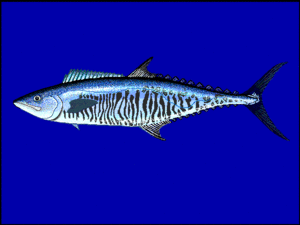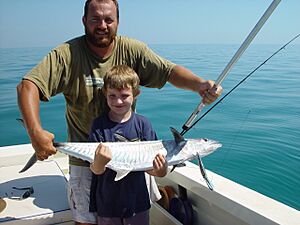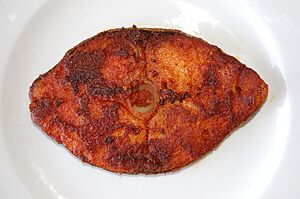Narrow-barred Spanish mackerel facts for kids
Quick facts for kids Narrow-barred Spanish mackerel |
|
|---|---|
 |
|
| Conservation status | |
| Scientific classification | |
 |
|
| Synonyms | |
|
The narrow-barred Spanish mackerel (Scomberomorus commerson) is a type of mackerel fish. It belongs to the Scombridae family, which includes tunas and other mackerels. This fish lives in a very large area, mostly around Southeast Asia. You can find it as far west as the east coast of Africa and the Middle East. It also lives along the northern parts of the Indian Ocean and as far east as the South West Pacific Ocean.
Contents
What They Look Like
These fish have bright blue to dark grey backs and sides. Their bellies are a silvery blue-grey color. Spanish mackerel have many thin, vertical lines running down their sides. They can grow quite large, up to about 200 centimeters (about 6.5 feet) long. They can also weigh up to 70 kilograms (about 154 pounds). In Australia, they are the biggest type of mackerel found.
Where They Live
The narrow-barred Spanish mackerel is found in a wide area. This area centers around Southeast Asia. It stretches west to the east coast of Africa and the Persian Gulf. It also goes along the northern coastal areas of the Indian Ocean. To the east, it reaches Fiji in the South West Pacific Ocean.
This fish is common along both sides of Australia. It goes as far south as Perth on the west coast. On the east coast, it reaches Sydney. You can also find it further north in China and even Japan. This fish was first seen in the Mediterranean Sea in 1935. It was found off the coast of what was then Mandatory Palestine. Now, it is very common in the eastern part of the Mediterranean. It has become an important fish for local fishing.
Life Cycle
Spanish mackerel lay their eggs in the ocean, usually near the edges of coral reefs. Their eggs have a large oil droplet. This helps them float near the surface of the water. The surface water is warmer and has lots of oxygen. It also has plenty of tiny food for the baby fish (larvae) when they hatch.
When they are very young larvae, Spanish mackerel seem to stay in groups of their own kind. They are not usually found with other types of mackerel from the same family. However, adult mackerel sometimes mix with different species.
These fish lay eggs at certain times of the year. In warmer tropical waters, they lay eggs for a longer period. Many fisheries catch these fish when they gather together to feed before spawning. In the Northern Territory of Australia, many female fish caught between July and December have either just laid eggs or are about to. Generally, Spanish mackerel lay eggs when the water is warmer. This helps ensure there is enough food for the fast growth of the larvae.
As the young larvae grow, they move from the open ocean where they hatched. They go closer to shore and into areas where rivers meet the sea (estuaries). Here, they spend their juvenile stage. In these inshore areas, they mostly eat tiny fish larvae and small crustaceans. As they get bigger, they start eating small fish and squid. Studies in Australia show that female Spanish mackerel grow larger than males. Female fish become ready to lay eggs at about two years old. This is when they are around 80 centimeters (about 31 inches) long.
What They Eat
Spanish mackerel are very hungry and eat many different things. They are carnivores, meaning they eat meat. Like other fish in their group, they mainly eat small fish. They also eat smaller amounts of shrimp and squid.
Fishing for Spanish Mackerel
The narrow-barred Spanish mackerel is a highly valued fish. People catch them across the Indo-West Pacific region. People who fish for fun (recreational anglers) catch them from boats. They do this by trolling (dragging a lure behind the boat) or by drifting. They also catch them from piers, jetties, and beaches. They use casting spoons, jigs, and live bait. Commercial fishermen mainly use large nets called gillnets. Sometimes, they also troll with lures, similar to those used by recreational anglers.
Australia
In July 2023, the government in Queensland, Australia, reduced the amount of fish commercial fishers could catch. The limit went from 578 tonnes to 165 tonnes. This is a big cut, down to only 27.5% of the old limit. The new plan splits the catch: 60% for commercial fishing, 40% for recreational fishing (including charter boats), and 2 tonnes per year for Indigenous communities. This change is meant to help the fish population grow back over time.
Taiwan
In Penghu, Taiwan, the narrow-barred Spanish mackerel is very valuable. People there call it "white gold." In 2022, a very large fish, weighing 34 kilograms (about 75 pounds), was sold for over $3,000! In Tainan, this fish is used to make a dish called tutuo yugeng. This is a thick soup made with Spanish mackerel.
Raising Them in Farms
In 2023, the Taiwanese Fisheries Research Institute had a big success. They managed to breed narrow-barred Spanish mackerel in captivity. This is a step towards raising them in fish farms (aquaculture).
Parasites
Like most fish, the narrow-barred Spanish mackerel can have different parasites. One interesting type of parasite is the cysts of a worm called Callitetrarhynchus gracilis. These cysts are often found in large numbers inside the fish's body.


Common Names
- Pakistan: Surmei سرمٸ
- South Africa: king mackerel, couta, cuda
- Malaysia: tenggiri
- Australia: narrow-bar, narrow-barred mackerel, snook, Spaniard, Spanish mackerel
- USA: barred mackerel, narrow-barred mackerel, striped seer
- Arabic: In Lebanon, it is called "abu sinn ابو سن" or"ghazal غزال". In Egypt's Mediterranean and the Red Sea it is "Dirak ديرك". In Arab states of the Persian Gulf, it is kanaad, kanad or kana'd كنعد.
- India: konem in Telugu, vanjaram in Tamil, anjal in Tulu, Shermai in Dhakhani Urdu,Surmai In Marathi , "Neymeen" "Aykoora" in Malayalam
- Iran: shir mahi شیرماهی
- Israel: Palamida (פלמידה), Squmbren zariz (סקומברן זריז, meaning quick Spanish mackerel)
- Philippines: tanigue
- Indonesia: ikan tenggiri
- Sri Lanka: Thora in Sinhalese, vanjaram in Tamil
- Somalia: Yuumbi
- Fiji: walu
- Thailand: plā xinthrī (ปลาอินทรี)
- Libyan: yamaneyah يمنيه.
- Taiwan: 土魠魚, "thô͘-thoh-hî", "tǔtuōyú"
- Dutch: koningsvis
- South China: majia (馬加魚)
See also
- Mackerel as food




